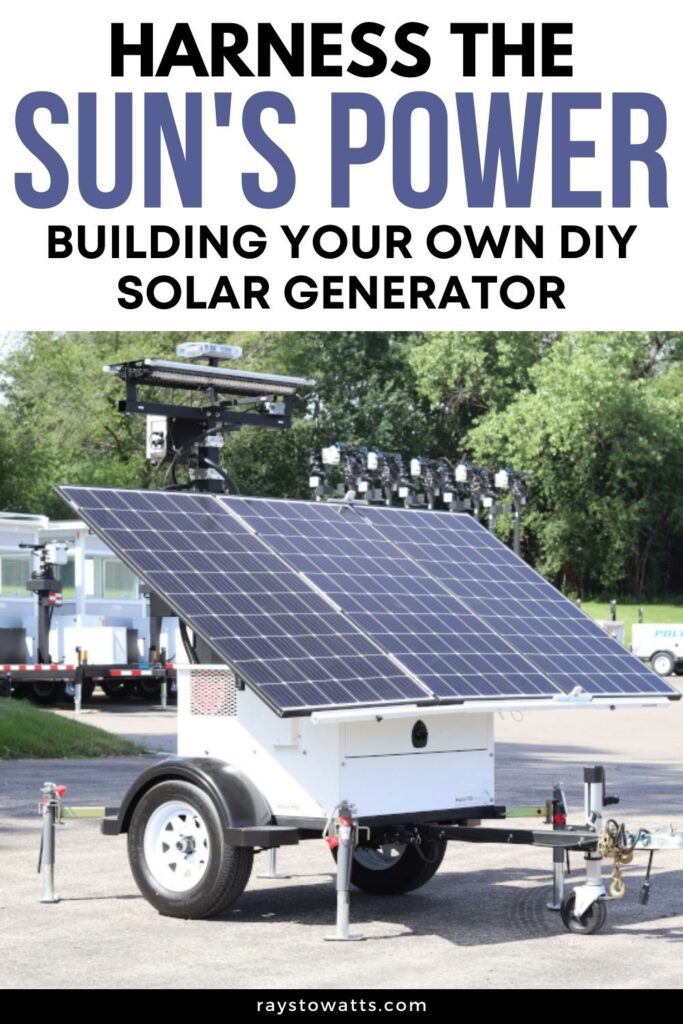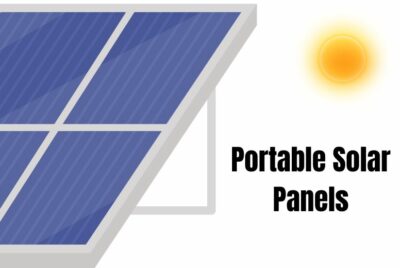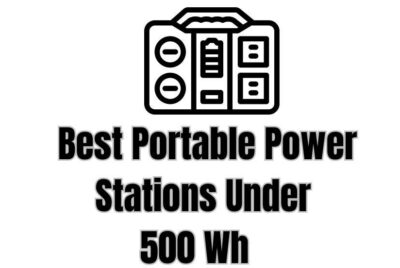Harnessing the Sun: Building Your Own DIY Solar Generator
I may earn a commission for purchases made through my links. It helps me run this site. Check out my disclosure for more details.
As someone who doesn’t want to be a slave to the grid and who likes to pack the RV up and travel frequently, I am thrilled to share with you a project that can solve a lot of your energy needs, if done right. Namely, the wonders of building your own DIY solar generator.
So, in this article, I will explain the benefits of constructing your own solar generator and provide you with step-by-step guidance to help you embark on this exciting journey towards sustainable energy independence.
Your Why
In the quest for clean and renewable energy, solar power has emerged as a frontrunner. DIY solar generators allow you to tap into the sun’s abundant energy and convert it into usable electricity. By constructing your own solar generator, you not only contribute to a greener future but also gain the freedom to power your devices and appliances wherever you go.
Let’s dive into the world of DIY solar generators and uncover their numerous benefits.
Understanding DIY Solar Generators
Before we delve into the construction process, let’s first understand what a DIY solar generator is. In essence, it is a self-contained system that harnesses the power of the sun through solar panels, stores the energy in batteries, and provides electricity through an inverter.
The beauty of a DIY solar generator lies in its simplicity and adaptability. You have the flexibility to customize the system based on your power requirements and budget.
Some Reasons To Build Your Own DIY Solar Generator
1. Renewable and Environmentally Friendly
Using a DIY solar generator means relying on a clean and renewable energy source. By harnessing the power of the sun, you reduce your carbon footprint and minimize dependence on fossil fuels. With solar energy, you can enjoy guilt-free electricity that is both sustainable and environmentally friendly.
2. Cost Savings
One of the most compelling reasons to construct a DIY solar generator is the long-term cost savings. While the initial investment may seem significant, the system pays for itself over time. Once installed, you harness free energy from the sun, eliminating or greatly reducing your reliance on traditional power sources. Say goodbye to escalating utility bills and enjoy significant savings in the years to come.
3. Energy Independence and Portability
A DIY solar generator offers you the freedom to generate power wherever you need it. Whether you’re camping in the wilderness or facing a power outage, your solar generator ensures a reliable source of electricity. With portable components and the ability to charge batteries, you can have power on-the-go, providing convenience and peace of mind.
4. Scalability and Expandability
When building your own solar generator, you have the flexibility to start small and expand over time. You can begin with a basic setup to meet your immediate needs and gradually add more solar panels and batteries as your energy requirements grow. This scalability allows you to tailor the system to your budget and adapt it as your lifestyle evolves.
Now that we understand the benefits, let’s dive into the step-by-step process of constructing your own DIY solar generator.
5. Cost Savings
Compared to premium brands like Jackery and Goal Zero you can save your self a lot of money by buying the parts yourself and constructing your own generator. Saying that, if you are not technically adept, or good with a bit of engineering, you could cause yourself a lot of heartache and blow a hole in your wallet. Sometimes you are better to invest the money with the professionals!
But if you like to tinker and feel you have the skills or are willing to learn, be brave and go for it! Where there’s a will theres a way.
Step 1: Assessing Power Needs
Before gathering the components, it’s crucial to assess your power needs. Make a list of the devices and appliances that you would like to run with your solar generator. Consider their wattage or power consumption to estimate the total energy requirement. Figure out how many watts your TV, coffee machine, mini fridge, and washing machine use per hour if that’s what you want to run. This assessment will guide you in choosing the right components for your system.
Step 2: Gathering the Necessary Components
To construct a DIY solar generator, you will need several key components. These include solar panels, batteries, an inverter, charge controller, wiring, connectors, and mounting hardware. Research reputable suppliers and select high-quality components that suit your budget and power requirements.
Step 3: Choosing the Right Solar Panels
Solar panels are the heart of your DIY solar generator, as they capture sunlight and convert it into electricity. Therefore you should opt for efficient and durable panels that match your power needs. Monocrystalline or polycrystalline panels are popular choices due to their reliability and efficiency. If you can get them, that is.
If not, work on creating the heart of your solar generator, the portable power station and buy a couple of cheap solar panels on Amazon.
Step 4: Selecting the Appropriate Battery
The battery is responsible for storing the energy generated by the solar panels for later use. Choose a deep-cycle battery with sufficient capacity to meet your power needs. Lead-acid batteries are not used that much in the solar generation industry, they are cheap but not as good as lithium-ion batteries, which provide better performance and longevity.
If you are really brave you can build a dual-battery system and have a more powerful system than you can buy. Though this adds to the complexity quite a bit.
Step 5: Incorporating an Inverter
The inverter converts the stored DC (direct current) energy stored inside the battery into AC (alternating current) electricity that powers most household devices. Select an inverter with adequate power capacity to handle your expected load. Pure sine wave inverters are recommended for their clean and stable power output.
Step 6: Wiring the System
Proper wiring is essential for a safe and efficient DIY solar generator. Connect the solar panels, battery, inverter, and charge controller using appropriate cables and connectors. Follow wiring diagrams and guidelines provided by the component manufacturers to ensure correct and secure connections.
Step 7: Mounting and Installing
Choose an optimal location for mounting the solar panels, considering factors such as sunlight exposure and accessibility. Secure the panels using mounting hardware and position them at the correct angle for maximum sun exposure. Install the batteries, inverter, and charge controller in a suitable location, ensuring proper ventilation and protection from the elements.
Step 8: Testing and Maintenance
Once the system is installed, perform thorough testing to ensure everything is functioning correctly. Monitor the performance of the solar panels, battery charge levels, and inverter output. Regular maintenance, such as cleaning the panels and checking connections, will optimize the system’s efficiency and longevity.
FAQs
1. How much does it cost to build a DIY solar generator? The cost of building a DIY solar generator can vary depending on the components and system size you choose. Generally, you can expect to spend several hundred to a few thousand dollars.
2. Can I connect my DIY solar generator to the grid? While it’s technically possible, connecting a DIY solar generator to the grid requires additional equipment and expertise. It’s advisable to consult a professional electrician to ensure compliance with local regulations.
3. How long do solar panels and batteries last? Solar panels typically have a lifespan of 25 years or more, while batteries can last anywhere from 5 to 15 years, depending on the type and usage.
4. Can I expand my DIY solar generator in the future? Yes, one of the advantages of DIY solar generators is their expandability. You can add more solar panels and batteries as your power needs grow.
5. Are DIY solar generators suitable for camping and outdoor activities?
Absolutely, they are ideal. Not only are they portable, but they are quiet, practically emit no noise, and they won’t cause any toxic fumes. They can also be charged on the go if you bring solar panels, or have access to AC Power. Failing that, just have yours fully charged before you leave the house.
Sourcing Parts
When it comes to sourcing parts for your DIY solar generator, there are several options available to you. Here are a few places where you can find the necessary components:
Online Solar Retailers
Numerous online retailers specialize in selling solar panels, batteries, inverters, and other solar components. Websites like Solar Direct, Wholesale Solar, and Solar Electric Supply offer a wide range of products and often provide detailed information and specifications to help you make informed decisions.
Local Solar Suppliers
Check if there are any local solar suppliers or renewable energy stores in your area. These establishments may carry a selection of solar components and can provide expert advice on choosing the right parts for your DIY solar generator.
Electronics and Hardware Stores
Some electronics stores or large hardware retailers may stock basic solar components such as solar panels, wiring, and connectors. While the selection may be limited, it’s worth checking if they carry the items you need.
Online Marketplaces
Platforms like Amazon, eBay, and Alibaba offer a wide range of solar components from various sellers. However, exercise caution and carefully read customer reviews and seller ratings before making a purchase to ensure quality and reliability.
Local Electrical Supply Stores
Visit local electrical supply stores that cater to electricians and contractors. They may carry or be able to order solar components, such as batteries and inverters, for you.
Solar Installers and Contractors
Reach out to local solar installers or contractors and check if they sell individual solar components. While their main focus is installation, some may be willing to provide you with the necessary parts or direct you to reputable suppliers.
Remember to compare prices, check customer reviews, and verify the quality and compatibility of the components before making a purchase. It’s also a good idea to consult online resources, forums, or DIY solar communities to gather insights and recommendations from experienced individuals who have built their own solar generators.
Cost Effective
Find out if the cost is worth all the effort. For a start if you only want something to get you buy for a day or two that you don’t need to run household appliances on, there are plenty of power stations you can pick up for under $200 that will do the job very well.
Conclusion
Congratulations! By constructing your own DIY solar generator, you have taken a significant step towards a sustainable and independent energy future. The benefits of harnessing the sun’s power are vast, from reducing your carbon footprint to enjoying long-term cost savings.
With careful planning, quality components, and attention to detail, you can create a reliable and efficient solar generator that powers your devices and appliances wherever you go.
Pin This…





